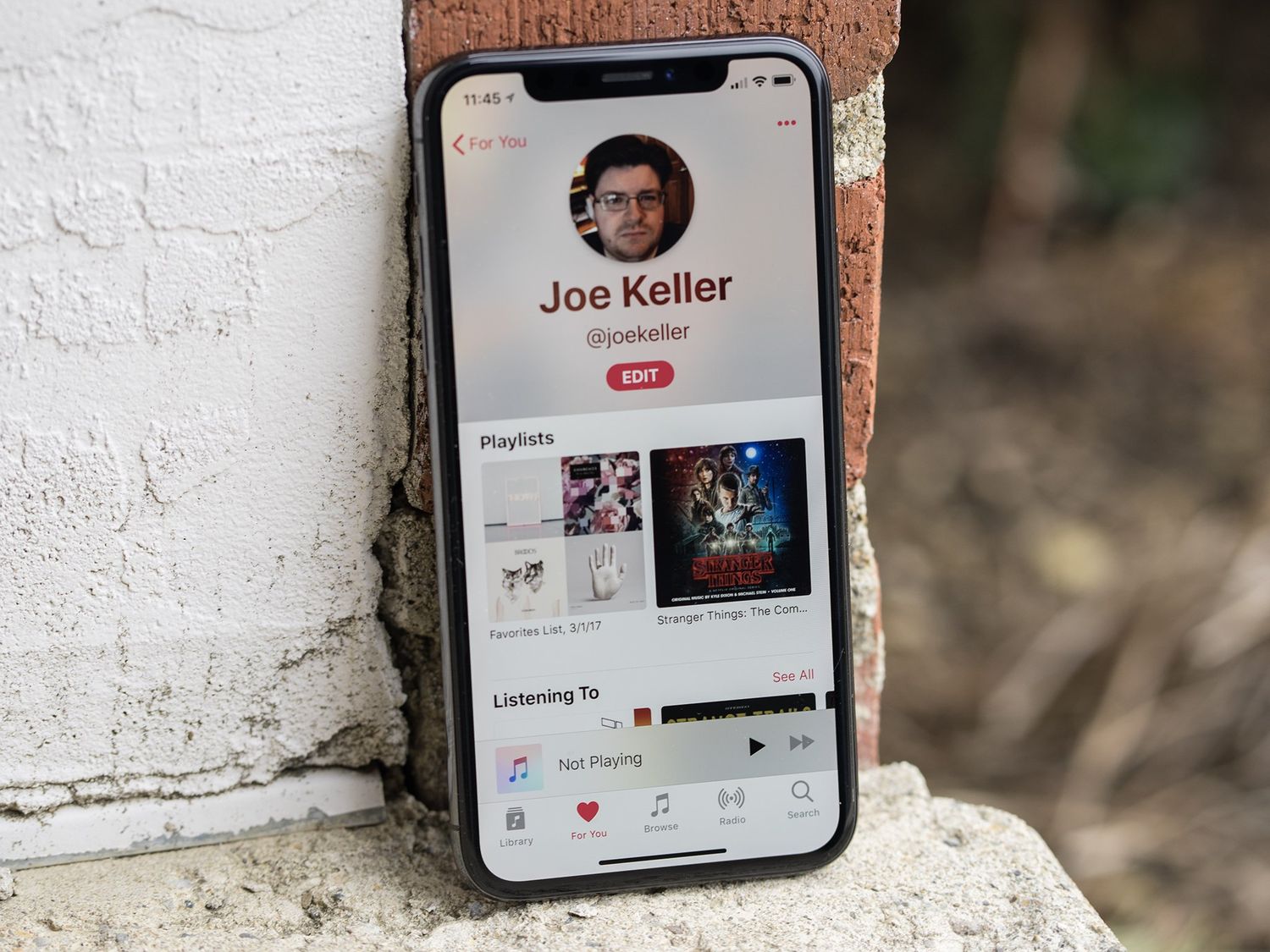Home>Production & Technology>Digital>How Much Does Digital Revenue In Music Account For Over The Years


Digital
How Much Does Digital Revenue In Music Account For Over The Years
Published: March 10, 2024
Discover the growth of digital revenue in the music industry over the years and its impact on the overall market. Explore the increasing significance of digital platforms in driving music sales and revenue.
(Many of the links in this article redirect to a specific reviewed product. Your purchase of these products through affiliate links helps to generate commission for AudioLover.com, at no extra cost. Learn more)
Table of Contents
Introduction
The music industry has undergone a remarkable transformation in recent years, with the advent of digital technology revolutionizing the way music is consumed and monetized. As we delve into the realm of digital revenue in music, it becomes evident that this facet of the industry has experienced a substantial evolution, reshaping the landscape of music distribution and consumption.
The emergence of digital platforms has significantly altered the traditional revenue streams within the music industry, presenting both challenges and opportunities for artists, record labels, and music streaming services. Understanding the dynamics of digital revenue in music is crucial for comprehending the current state of the industry and predicting its future trajectory.
In this article, we will explore the evolution of digital revenue in the music industry, shedding light on the factors that have fueled its growth and the impact of streaming services on its proliferation. Additionally, we will delve into the comparison between digital revenue and physical sales, highlighting the shifting dynamics of music consumption and revenue generation.
As we embark on this exploration, it is essential to recognize the pivotal role of digital technology in shaping the contemporary music landscape. The rise of digital revenue has not only transformed the way music is distributed and consumed but has also presented artists and industry stakeholders with new avenues for revenue generation. By delving into the nuances of digital revenue in music, we can gain valuable insights into the industry's current state and its potential for further evolution and innovation.
The next sections will delve deeper into the factors contributing to the growth of digital revenue, the comparison between digital revenue and physical sales, the impact of streaming services, and the challenges and opportunities that lie ahead for digital revenue in the music industry. Through this exploration, we aim to provide a comprehensive understanding of the multifaceted nature of digital revenue in music and its implications for the industry as a whole.
The Rise of Digital Revenue in Music
The rise of digital revenue in the music industry marks a pivotal shift in the way music is consumed, distributed, and monetized. This transformative phenomenon has reshaped the traditional revenue streams, presenting a dynamic landscape for artists, record labels, and music streaming platforms. The evolution of digital revenue can be attributed to the proliferation of digital platforms, the advent of streaming services, and the changing consumer behavior.
Digital revenue encompasses a broad spectrum of income generated through digital music sales, streaming, downloads, and licensing. With the emergence of digital platforms such as iTunes, Spotify, and Amazon Music, music consumption has transcended physical boundaries, allowing listeners to access a vast catalog of music at their fingertips. This accessibility has not only expanded the reach of music but has also opened new avenues for revenue generation.
The transition from physical sales to digital formats has been a defining factor in the rise of digital revenue. As CDs and vinyl records made way for digital downloads and streaming, the music industry witnessed a fundamental shift in consumer preferences. The convenience of accessing music on digital platforms, coupled with the ability to curate personalized playlists, has propelled the growth of digital revenue, reflecting the evolving nature of music consumption.
Moreover, the global reach of digital platforms has facilitated the international distribution of music, enabling artists to connect with a diverse audience across borders. This globalization of music consumption has contributed to the expansion of digital revenue streams, offering artists the opportunity to garner revenue from a broader demographic.
The rise of digital revenue has also been fueled by the increasing prevalence of subscription-based streaming services. Platforms such as Spotify, Apple Music, and Tidal have revolutionized the music industry by offering users access to an extensive library of music for a monthly fee. This shift towards subscription-based models has not only redefined the revenue structure but has also influenced consumer behavior, encouraging a transition from ownership to access.
In essence, the rise of digital revenue in music signifies a paradigm shift in the industry, characterized by the convergence of technology, consumer behavior, and revenue models. As digital platforms continue to evolve and innovate, the landscape of music consumption and revenue generation is poised for further transformation, presenting new opportunities and challenges for artists and industry stakeholders alike.
Factors Contributing to the Growth of Digital Revenue
The growth of digital revenue in the music industry can be attributed to a confluence of factors that have reshaped the dynamics of music consumption and revenue generation. These factors have not only propelled the expansion of digital revenue streams but have also redefined the traditional paradigms of music distribution and monetization.
-
Digital Platforms and Accessibility: The proliferation of digital platforms such as iTunes, Amazon Music, and Google Play has significantly enhanced the accessibility of music. With the advent of digital storefronts and online music stores, listeners can easily purchase and download individual tracks or entire albums, transcending the limitations of physical distribution. This accessibility has broadened the reach of music, enabling artists to connect with a global audience and capitalize on digital sales.
-
Streaming Services and Subscription Models: The rise of streaming services, characterized by platforms like Spotify, Apple Music, and Tidal, has revolutionized the music industry. These platforms offer users access to an extensive catalog of music for a monthly subscription fee, fostering a shift from ownership to access. The convenience and affordability of subscription-based models have contributed to the steady growth of digital revenue, as consumers embrace the concept of unlimited, on-demand music streaming.
-
Globalization of Music Consumption: Digital platforms have facilitated the globalization of music consumption, transcending geographical boundaries and enabling artists to reach a diverse, international audience. This globalization has not only expanded the potential consumer base but has also diversified the revenue streams for artists, as their music resonates with listeners across different regions and cultures.
-
Mobile Technology and On-the-Go Listening: The ubiquitous nature of mobile devices has played a pivotal role in driving digital revenue growth. With smartphones and tablets serving as primary devices for music consumption, listeners can enjoy music on-the-go, leveraging streaming services and digital downloads. This seamless integration of music into everyday life has bolstered digital revenue, as consumers embrace the convenience of accessing music anytime, anywhere.
-
Diverse Monetization Channels: Digital revenue growth has been further propelled by the diversification of monetization channels within the music industry. In addition to sales and streaming, artists can leverage licensing opportunities, sync placements, and digital royalties, expanding their revenue streams beyond traditional album sales. This diversification has empowered artists to capitalize on their music across various platforms and media, contributing to the overall growth of digital revenue.
In essence, the growth of digital revenue in the music industry is underpinned by a multifaceted interplay of digital platforms, streaming services, global accessibility, mobile technology, and diversified monetization channels. These factors collectively drive the expansion of digital revenue streams, shaping a dynamic landscape for artists, record labels, and music industry stakeholders. As the music industry continues to evolve, these factors will remain instrumental in fueling the growth and innovation of digital revenue.
Digital Revenue vs. Physical Sales
The dichotomy between digital revenue and physical sales represents a fundamental shift in the dynamics of music consumption and revenue generation. While physical sales have long been the traditional cornerstone of the music industry, the advent of digital revenue has ushered in a new era characterized by accessibility, convenience, and evolving consumer preferences.
Digital Revenue: The Era of Accessibility and Convenience
Digital revenue encompasses a spectrum of income generated through digital music sales, streaming, downloads, and licensing. The rise of digital platforms such as iTunes, Spotify, and Amazon Music has transformed the landscape of music distribution, offering listeners unparalleled accessibility to a vast catalog of music. With the click of a button, consumers can purchase individual tracks or entire albums, instantly adding them to their digital libraries. This seamless accessibility has transcended geographical boundaries, enabling artists to connect with a global audience and capitalize on digital sales. Moreover, the advent of subscription-based streaming services has redefined the revenue structure, fostering a shift from ownership to access. Consumers can now enjoy unlimited, on-demand music streaming for a monthly fee, revolutionizing the way music is consumed and monetized.
Physical Sales: Nostalgia and Tangibility in a Digital Age
In contrast, physical sales, encompassing CDs, vinyl records, and other tangible formats, have long been emblematic of the music industry. While digital revenue has surged in recent years, physical sales continue to resonate with a niche demographic of enthusiasts who value the tactile experience of owning physical music. The allure of album artwork, liner notes, and the ritual of browsing through record stores has sustained the appeal of physical sales, evoking a sense of nostalgia and authenticity in an increasingly digital landscape. Despite the decline in overall physical sales, collectors and audiophiles continue to champion the tangible allure of physical music formats, underscoring their enduring significance in the music industry.
The Shifting Dynamics of Music Consumption and Revenue Generation
The coexistence of digital revenue and physical sales underscores the evolving nature of music consumption and revenue generation. While digital revenue has surged ahead as the primary revenue driver, physical sales continue to carve out a niche within the industry, appealing to collectors, aficionados, and those who cherish the tangible aspects of music ownership. The dichotomy between digital revenue and physical sales reflects the diverse preferences of music consumers, encompassing both the allure of digital accessibility and the enduring appeal of physical tangibility.
In essence, the juxtaposition of digital revenue and physical sales encapsulates the multifaceted nature of the music industry, where traditional and contemporary paradigms intersect to cater to a diverse spectrum of consumer preferences. As the industry continues to evolve, the coexistence of digital revenue and physical sales underscores the dynamic interplay between accessibility, nostalgia, and evolving consumer behaviors, shaping the trajectory of music consumption and revenue generation.
The Impact of Streaming Services on Digital Revenue
The advent of streaming services has exerted a profound impact on the landscape of digital revenue in the music industry, reshaping the dynamics of music consumption, revenue generation, and artist-audience engagement. Streaming services, characterized by platforms such as Spotify, Apple Music, and Tidal, have revolutionized the way music is accessed, experienced, and monetized, ushering in a new era of on-demand, unlimited music streaming.
One of the most significant impacts of streaming services on digital revenue lies in the transition from ownership to access. Unlike traditional music purchases, which involved buying individual tracks or albums, streaming services offer users a vast catalog of music for a monthly subscription fee. This shift in consumer behavior has redefined the revenue structure, as artists and record labels earn revenue based on the number of streams their music accrues. While this model has sparked debates regarding equitable compensation for artists, it has undeniably contributed to the steady growth of digital revenue, reflecting the evolving nature of music consumption.
Moreover, streaming services have democratized music discovery and consumption, offering users access to a diverse array of artists, genres, and curated playlists. This democratization has not only broadened the reach of music but has also provided emerging artists with a platform to showcase their work to a global audience. As a result, streaming services have become instrumental in driving digital revenue growth, enabling artists to capitalize on the expansive reach and discoverability offered by these platforms.
The data-driven nature of streaming services has also had a profound impact on digital revenue, providing artists and record labels with valuable insights into listener preferences, geographic trends, and audience demographics. This data-driven approach has empowered artists to tailor their marketing strategies, tour schedules, and content creation based on real-time analytics, thereby optimizing their revenue generation potential.
Furthermore, streaming services have redefined the concept of music curation and personalized playlists, allowing users to discover new music based on their listening habits and preferences. This personalized approach has not only enhanced the user experience but has also presented artists with opportunities for increased exposure and revenue generation, as their music is recommended to listeners who align with their target demographic.
In essence, the impact of streaming services on digital revenue in the music industry is multifaceted, encompassing shifts in consumer behavior, democratized music discovery, data-driven insights, and personalized curation. As streaming services continue to evolve and innovate, their impact on digital revenue is poised to shape the future trajectory of the music industry, presenting both challenges and opportunities for artists, record labels, and industry stakeholders.
Challenges and Opportunities for Digital Revenue in Music
The evolution of digital revenue in the music industry has ushered in a paradigm shift, presenting a myriad of challenges and opportunities for artists, record labels, and music streaming services. Understanding these dynamics is crucial for navigating the complexities of the contemporary music landscape and harnessing the potential for sustainable revenue generation.
Challenges
Monetization Equity
One of the primary challenges in the realm of digital revenue lies in achieving equitable monetization for artists, particularly in the context of streaming services. The debate surrounding fair compensation for artists in the streaming era has underscored the need for transparent revenue models that ensure creators receive just compensation for their work. Addressing this challenge requires industry-wide collaboration to establish fair royalty structures and revenue distribution mechanisms that uphold the value of artistic content.
Market Saturation and Discoverability
As the digital music market becomes increasingly saturated with a vast array of content, the challenge of discoverability looms large for emerging artists. Navigating the competitive landscape of digital platforms and streaming services necessitates strategic marketing efforts and targeted promotional initiatives to ensure visibility and audience engagement. The sheer volume of music available online poses a challenge in capturing the attention of listeners and standing out amidst the abundance of content.
Piracy and Copyright Infringement
The prevalence of digital piracy and copyright infringement continues to pose a significant challenge to digital revenue in the music industry. Illicit distribution of music through unauthorized channels undermines legitimate revenue streams, impacting artists' ability to derive income from their creative endeavors. Combatting piracy requires robust enforcement measures, technological innovations, and educational initiatives to foster a culture of respect for intellectual property rights.
Opportunities
Global Reach and Audience Engagement
Digital platforms and streaming services offer artists unparalleled opportunities to connect with a global audience, transcending geographical boundaries and cultural barriers. Leveraging these platforms enables artists to cultivate a diverse fan base, engage with listeners from different regions, and capitalize on the international appeal of their music. The potential for global reach presents artists with avenues for expanding their fan base and diversifying their revenue streams through international audience engagement.
Data-Driven Insights and Targeted Marketing
The data-centric nature of digital platforms empowers artists and record labels with valuable insights into listener preferences, consumption patterns, and demographic trends. This data-driven approach presents opportunities for targeted marketing, personalized content creation, and strategic decision-making. By harnessing actionable insights derived from digital analytics, artists can optimize their marketing strategies, tailor their content to resonate with their audience, and maximize their revenue generation potential.
Diversified Revenue Streams
The digital landscape offers artists the potential to diversify their revenue streams beyond traditional music sales. Opportunities for licensing, sync placements, merchandise sales, and live performance revenue abound in the digital realm, providing artists with avenues for holistic revenue generation. Embracing these diversified revenue streams enables artists to cultivate a sustainable income model that extends beyond digital sales and streaming royalties.
In essence, the challenges and opportunities inherent in digital revenue in the music industry underscore the dynamic nature of the contemporary music landscape. Navigating these complexities requires a strategic approach, innovative thinking, and a proactive stance towards leveraging the potential for sustainable revenue generation in the digital era. By addressing the challenges and capitalizing on the opportunities, artists and industry stakeholders can chart a course towards a thriving digital revenue ecosystem that fosters creativity, innovation, and equitable compensation for artistic content.
Conclusion
The evolution of digital revenue in the music industry represents a transformative journey characterized by technological innovation, shifting consumer behaviors, and the redefinition of traditional revenue models. As we reflect on the multifaceted dynamics of digital revenue, it becomes evident that this paradigm shift has reshaped the music landscape, presenting both challenges and opportunities for artists, record labels, and music streaming services.
The rise of digital revenue, propelled by factors such as the proliferation of digital platforms, the advent of streaming services, and the globalization of music consumption, has redefined the revenue structure, offering artists new avenues for reaching a global audience and capitalizing on diverse revenue streams. The dichotomy between digital revenue and physical sales underscores the evolving nature of music consumption, catering to a diverse spectrum of consumer preferences encompassing digital accessibility and the enduring appeal of physical tangibility.
The impact of streaming services on digital revenue has been profound, revolutionizing the way music is accessed, experienced, and monetized. While streaming services have democratized music discovery, provided valuable data-driven insights, and redefined the concept of personalized curation, they have also posed challenges related to equitable monetization, market saturation, and piracy.
Navigating the complexities of digital revenue in the music industry requires a strategic approach to address challenges such as monetization equity, market saturation, and piracy, while capitalizing on opportunities for global reach, data-driven insights, and diversified revenue streams. By embracing these opportunities and addressing the challenges, artists and industry stakeholders can chart a course towards a thriving digital revenue ecosystem that fosters creativity, innovation, and equitable compensation for artistic content.
In essence, the evolution of digital revenue in the music industry signifies a pivotal juncture, where the convergence of technology, consumer behavior, and revenue models has reshaped the industry's trajectory. As digital platforms continue to evolve and innovate, the landscape of music consumption and revenue generation is poised for further transformation, presenting new opportunities for sustainable revenue generation and artistic expression in the digital era.











